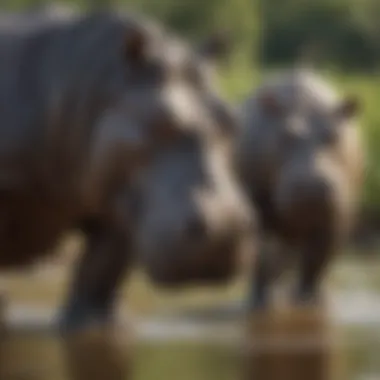Unveiling the Enigmatic Universe of Hippopotamuses


Animal Species Profile
Hippos, scientifically known as Hippopotamus amphibius, are some of the most intriguing creatures inhabiting the waterways and grasslands of Africa. Their physical appearance is characterized by massive bodies that can weigh up to 4,500 kilograms, coupled with barrel-shaped torsos and wide mouths filled with intimidating tusks. These semi-aquatic mammals spend a significant amount of time submerged in water to keep their massive bodies cool under the scorching African sun.
Their natural habitat includes rivers, lakes, and swamps across sub-Saharan Africa, where they can freely roam and forage for vegetation at night. Despite their seemingly docile nature, hippos are fiercely territorial animals, known for their aggressive behaviors, especially during mating season. Within their social groups, hippos display complex communication patterns through vocalizations, visual signals, and body postures, indicating their hierarchical structures and forming alliances for protection.
Conservation & Wildlife Efforts
The conservation status of hippos is a growing concern due to habitat loss, poaching activities, and conflicts with human settlements. These factors have led to a decline in their population numbers, warranting urgent conservation initiatives to safeguard their existence. Organizations such as the Hippo Specialist Group and African wildlife reserves are actively involved in protecting hippos through habitat preservation, anti-poaching patrols, and community education programs.
Protecting hippos not only ensures the preservation of a keystone species within their ecosystems but also contributes to the overall biodiversity of their habitats. Through collaborative efforts and stringent enforcement of anti-poaching laws, success stories have emerged, demonstrating significant population recoveries in certain regions and highlighting the positive impact of conservation strategies on hippo populations.
Animal Behavior & Psychology
Hippos exhibit a fascinating array of behaviors and psychology, showcasing their intelligence and social dynamics within their groups. Communication among hippos involves a diverse range of vocalizations, including grunts, wheezes, and honks, along with visual cues such as ear wiggling and yawning to convey dominance or submission.
Reproductive behavior in hippos is a crucial aspect of their social structure, with intricate rituals and displays during courtship and mating rituals. Female hippos play a crucial role in parenting, fiercely protecting their calves and teaching them essential survival skills in the wild. Moreover, hippos display remarkable cognitive abilities, from problem-solving skills to memory retention, enabling them to navigate their environments and adapt to varying circumstances.
Unique Facts & Trivia
Delving into the world of hippos reveals intriguing facts and trivia that highlight their extraordinary adaptations and behaviors. Did you know that hippos secrete a natural sunscreen-like substance that protects their skin from sunburn and dehydration? Additionally, these massive mammals can hold their breath underwater for up to five minutes, showcasing their remarkable aquatic prowess.
Surprisingly, despite their bulky bodies, hippos can outrun humans on land, reaching impressive speeds when provoked or facing threats. Their quirky behaviors include 'dung showering,' where hippos use their tails to spread feces as a form of territorial marking, further emphasizing their unique and sometimes humorous habits.
Pet Care & Tips
While hippos are captivating animals to observe in the wild, they are not suitable as pets due to their size, specialized diet, and territorial nature. However, for individuals keen on fostering a fascination with hippos, visiting reputable zoos and wildlife sanctuaries offers a glimpse into their world while supporting conservation efforts.
Understanding the basic care requirements and habitat needs of hippos is essential for their well-being in captive settings, ensuring proper diet, spacious enclosures with access to water, and enrichment activities to stimulate their mental and physical health. By promoting education and awareness about hippos, individuals can contribute to their conservation and appreciation for these majestic creatures.
Introduction to Hippos
Hippos hold a significant place in the animal kingdom, their existence intriguing many due to their peculiar traits and behaviors. Amidst diverse wildlife species, hippos stand out with their massive size and unique habitats. This section will provide a detailed overview discussing the defining characteristics that make hippos such fascinating creatures for enthusiasts and researchers alike.
Defining Hippos
Morphological Features
When delving into the world of hippos, their morphological features play a crucial role in understanding their evolutionary adaptations. The distinct bulky body, barrel-shaped torsos, and webbed feet are key attributes reflecting their aquatic lifestyle. These features enable them to navigate through water bodies effortlessly, showcasing their proficiency in both land and water habitats. Despite their seemingly cumbersome appearance, these anatomical elements enhance their survival strategies in their natural environment, allowing them to thrive and remain resilient amidst various ecological challenges.


Evolutionary History
Exploring the evolutionary history of hippos unveils a fascinating journey spanning millions of years. Tracing back to their ancestors, these mammals have undergone remarkable transformations to adapt to changing landscapes and environmental pressures. Their evolutionary path showcases a series of adaptations that have helped them emerge as one of the most intriguing wildlife species today. Understanding their evolutionary history sheds light on the survival mechanisms and behavioral patterns that have shaped modern-day hippos.
Taxonomic Classification
Order and Family
The taxonomic classification of hippos reveals insights into their genetic lineage and evolutionary relationships within the animal kingdom. Categorized under the order Artiodactyla and belonging to the family Hippopotamidae, hippos share phylogenetic connections with various hoofed mammals. This classification not only aids in identifying their biological affiliations but also underscores the importance of studying their genetic diversity and phylogenetic evolution to comprehend their ecological roles and biodiversity conservation.
Habitat and Distribution
Natural Habitats
Hippos primarily inhabit freshwater ecosystems such as rivers, lakes, and swamps across sub-Saharan Africa. Their reliance on aquatic environments for food and shelter underscores their crucial role in shaping the biodiversity of these regions. Their presence not only influences the ecological balance within these habitats but also highlights their significance as keystone species. Understanding the specifics of their natural habitats is essential to grasp the intricate ecological relationships they maintain within their unique environments.
Global Distribution
Considering the global distribution of hippos reveals their presence in various countries across Africa, emphasizing their adaptability to a range of climates and landscapes. From the tropical regions of West Africa to the savannas of East Africa, hippos exhibit a versatile distribution pattern shaped by their habitat preferences and resource availability. Examining their global dispersion provides valuable insights into the factors influencing their population dynamics and conservation status on a broader scale.
Physical Characteristics
Hippos possess unique physical characteristics that set them apart in the animal kingdom. These features play a crucial role in their survival and everyday functions. The size, weight, skin, coloration, and dental structure of hippos all contribute to their fascinating nature.
Size and Weight
The size and weight of hippos are noteworthy aspects of their physical characteristics. Adult hippos can reach impressive dimensions, with variations observed across different subspecies. The sheer bulk of hippos gives them an advantage in their aquatic habitats, allowing them to maneuver effectively and compete for resources.
Adult Dimensions
Adult hippos are known for their substantial size, with males often larger than females. This size difference plays a role in their social dynamics and mating behaviors. The weight of an adult hippo can exceed several thousand pounds, emphasizing their dominance in their environment.
Variations Across Subspecies
Across subspecies, variations in size and weight can be observed. These differences are influenced by factors such as habitat and available resources. The adaptability of hippos to varying conditions is reflected in the diverse sizes seen among different populations.
Skin and Coloration
Hippos exhibit unique adaptations in their skin and coloration, specifically tailored for their semi-aquatic lifestyle. These adaptations provide them with advantages for thriving in their watery habitats.


Adaptations for Aquatic Life
The skin of hippos is thick and hairless, offering protection from the sun and water. Their unique coloration helps regulate body temperature and provides camouflage in the water. These adaptations are essential for their survival in both aquatic and terrestrial environments.
Dental Structure
The dental structure of hippos is designed to support their herbivorous diet. Their teeth are specialized for grinding tough vegetation, showcasing the evolutionary adaptations that enable them to thrive on a plant-based diet.
Herbivorous Diet Implications
Hippos rely on their dental structure to process large amounts of grass and aquatic plants. Their molars are crucial for breaking down fibrous materials, aiding in digestion. This specialized dental adaptation is fundamental to their herbivorous lifestyle.
1. Behavioral Insights
Hippos are known for their intriguing behavioral patterns, making the exploration of this aspect a key highlight of this article. Understanding the behavior of hippos offers valuable insights into their social interactions, feeding habits, and overall survival strategies. By delving deep into their behavioral nuances, readers can appreciate the complexities of hippo society and how they adapt to their environment. Analyzing behavioral insights provides a fascinating glimpse into the inner workings of these semiaquatic mammals, shedding light on their unique personalities and instincts.
Social Structure
Group Dynamics
Exploring the group dynamics of hippos reveals a remarkable social structure within their communities. These creatures exhibit strong bonds within their groups, fostering cooperation and mutual protection. The cohesive nature of hippo groups ensures collective security, especially against common threats like predators. The significance of group dynamics lies in the shared responsibility for group members' well-being, enhancing their chances of survival in the wild. Despite occasional conflicts within the group hierarchy, the overall consensus-driven approach contributes to the successful navigation of their dynamic ecosystem.
Communication Methods
Hippos employ a diverse range of communication methods to convey messages within their groups effectively. These methods include vocalizations, body postures, and olfactory cues to facilitate cooperation and express emotions. Clear and distinct communication plays a crucial role in maintaining group cohesion and fostering interconnectedness among members. Each communication method serves a specific purpose, whether it is signaling danger, marking territory, or initiating social interactions. The unique feature of hippo communication lies in its multifaceted nature, allowing for nuanced interactions that strengthen social bonds and reinforce hierarchies.
Reproduction Patterns
Mating Behaviors
The mating behaviors of hippos are pivotal in understanding their reproductive strategies and population dynamics. From elaborate courtship rituals to competitive displays, these behaviors are essential for mate selection and successful mating. Studying their mating behaviors offers insights into how these creatures ensure genetic diversity and adaptability within their populations. The key characteristic of hippo mating behaviors is their intricacy, involving complex rituals that highlight the importance of pair bonding and mate choice for long-term reproductive success.
Gestation Period
The gestation period among hippos is a critical aspect of their reproduction, influencing population growth and genetic variability. Understanding the gestation period sheds light on the challenges and vulnerabilities faced by pregnant female hippos. This period is marked by increased maternal care and protection, as well as physiological changes to support fetal development. The unique feature of the hippo gestation period is its duration, which plays a significant role in shaping the population dynamics and demographic composition of hippo groups.
Territorial Behavior
Defense Strategies


Territorial behavior in hippos revolves around the protection of their habitats and resources from intruders and rivals. Their defense strategies encompass territorial marking, aggression, and vocal warnings to deter potential threats. The key characteristic of hippo defense strategies is the proactive nature of their responses to perceived threats, showcasing their territorial ownership and dominance. By understanding these strategies, one gains insights into how hippos establish and maintain their territories, ensuring their survival and reproductive success.
Ecological Importance
Keystone Species Role
Hippos have a unique Keystone Species Role due to their impact on vegetation through grazing and trampling activities. As herbivores, they influence plant growth patterns, which, in turn, shape the composition of local flora and maintain diverse habitats for numerous organisms. Their role as seed dispersers contributes to forest regeneration, demonstrating their pivotal position in sustaining the entire ecosystem.
Impact on Aquatic Environments
In considering the Impact on Aquatic Environments, hippos significantly affect freshwater ecosystems where they inhabit. They play a crucial role in nutrient cycling by consuming vegetation from land and depositing feces in the water, enriching aquatic habitats. Additionally, their wallowing behavior creates depressions that serve as microhabitats for various aquatic species, showcasing the intricate connections hippos have with their watery surroundings.
Significance for Freshwater Ecosystems
The Significance for Freshwater Ecosystems stems from hippos' influence on water quality and biodiversity in rivers and lakes. Their presence contributes to the health of aquatic ecosystems by regulating algal growth and maintaining balanced nutrient levels. As one of Africa's largest herbivores, hippos actively shape the structure and dynamics of freshwater habitats, highlighting their pivotal role in preserving these vital environments.
Conservation Concerns
The Conservation Concerns related to hippos raise important issues regarding their vulnerable status and the need for effective protection measures. Threats such as habitat loss, poaching, and human-wildlife conflicts pose significant risks to hippo populations, emphasizing the urgency of conservation efforts. Understanding these challenges is essential for formulating conservation strategies that address the complex interactions between hippos and their changing environments.
Threats and Protection Efforts
The Threats and Protection Efforts section examines the specific conservation challenges faced by hippos, from illegal hunting for their ivory tusks to habitat destruction from human activities. Conservation initiatives focusing on habitat preservation, anti-poaching measures, and community engagement are crucial for safeguarding hippos and their habitats. By highlighting threats and proposing conservation strategies, this article aims to raise awareness about the importance of protecting these iconic animals.
The section on 'Human-Hippo Interactions' delves into the intricate relationship between humans and hippos. This aspect of the article sheds light on the historical perspectives, current challenges, and the role of tourism and education in enhancing our understanding of these majestic creatures. By exploring how humans and hippos have interacted over time, readers will gain insights into the significance of coexisting with wildlife and fostering conservation efforts in the present day.
Historical Perspectives
Cultural Depictions
Discussing Cultural Depictions offers a glimpse into how hippos have been portrayed in various cultures throughout history. This section examines the symbolic significance of hippos, their representation in art and folklore, and the cultural meanings attached to these magnificent animals. By exploring the unique artistic interpretations and beliefs surrounding hippos, readers can appreciate the diverse historical contexts that have shaped human perceptions of these creatures.
Ancient Symbolism
Exploring Ancient Symbolism uncovers the deep-rooted significance of hippos in ancient civilizations. This subsection delves into the spiritual and symbolic connotations attached to hippos in ancient rituals, myths, and beliefs. By delving into the ancient symbolism of hippos, readers can grasp the enduring legacy of these animals in human societies and the profound impact they have had on historical narratives and cultural practices.
Current Challenges
Human-Wildlife Conflict
The discussion on Human-Wildlife Conflict highlights the complexities of interactions between humans and hippos in contemporary environments. This section explores the challenges posed by habitat encroachment, agricultural conflicts, and safety concerns associated with hippos in proximity to human settlements. By examining the nuances of human-hippo conflicts, readers can understand the delicate balance required to ensure the coexistence of both species in shared landscapes.
Tourism and Education
Eco-Tourism Initiatives
The segment on Eco-Tourism Initiatives focuses on initiatives that promote sustainable tourism practices and educate the public about hippos and their habitats. By showcasing the positive impact of eco-tourism on conservation efforts, this section emphasizes the importance of responsible tourism in preserving hippo populations and their ecosystems. Readers will gain insights into how eco-tourism initiatives can contribute to raising awareness, supporting local communities, and safeguarding the natural heritage of hippos for future generations.







